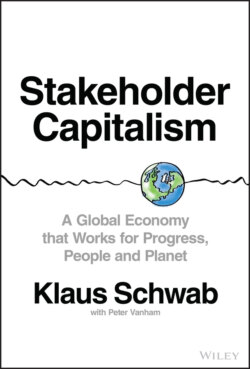Читать книгу Stakeholder Capitalism - Klaus Schwab - Страница 22
Low-Interest Rates and Low Inflation
ОглавлениеThere was one life buoy for low growth and debt until now: low interest rates. Having a low interest on your loan, as many homeowners or student borrowers know, is a blessing. It allows you to pay back your debt without having to worry about the debt load getting larger.
Since the financial crisis, central banks have ushered in an era of low lending rates, giving governments, companies, and consumers low interest rates as a form of relief. The goal is to, ultimately, restore higher growth as people consume more, companies invest more, and governments spend more.
In the United States, the Federal Reserve kept interest rates near zero from 2009 until 2016. It then gradually raised them again to 2.5 percent, half the historical normal rate. But in 2019, the Fed once again cut interest rates28 several times, and when COVID hit, it crashed back down to 0.25 percent.29 Given the challenging macroeconomic environment, a return to the era of high interest rates is very unlikely anytime soon. In other advanced economies, rates are even lower. The European Central Bank has kept its key borrowing rate for the eurozone at under 1 percent since 2012, and at zero since 2016. Most other European countries have similar low rates; Japan and Switzerland even charge depositors for buying bonds, in fact meaning they have a negative interest rate.
As indicated, this is a blessing for governments, companies, and individuals alike who are willing and able to take up new loans or for governments who want to refinance their historical debt. Some observers may even go as far as to suggest the historical debt-to-GDP burden is not as big a problem as it seems, as it can be perpetually refinanced.
But this view fails to consider that repayment problems can quickly get out of hand as government funding gaps for other liabilities increase. Costs related to pensions, health care, and infrastructure are becoming an ever-growing burden on governments, not to speak of consumption subsidies, such as governments paying a part of oil and gas prices for consumers.30 They produce low-quality debt and are hard to roll back, given their popularity with voters.
Public health care spending, notably, already rose by 66 percent from 2000 to 2016—long before the COVID-19 crisis hit—according to the World Health Organization.31 During the same period, GDP growth in OECD countries was only 19 percent. In aggregate, public health care spending in OECD countries now represents close to 7 percent of GDP, with peaks in the United States and Switzerland at double that rate, and that percentage can be expected to rise further as populations age and more viruses or even non-communicable diseases threaten the population. Unless governments can unload these costs to their citizens, many will increasingly struggle to balance their books.
There are more growing government liabilities. The Global Infrastructure Hub calculated the world faces a $15 trillion infrastructure funding gap from 2016 to 2040.32 But infrastructure represents an investment, on which a return could be earned. The problem posed by pensions and retirement savings is an order of magnitude larger, and returns are much lower: unless policies are changed, the World Economic Forum estimates33 the pension savings gap will balloon to $400 trillion in the eight countries with the world's largest pension systems by 2050, with unsecured public pension promises making up the lion's share of that shortfall.
On top of this debt burden is low inflation. Historically, interest rates and inflation tended to be inversely correlated, and central banks used their power to set interest rates as a tool to either curb inflation or stimulate it. By setting high interest rates, central banks gave people, companies, and governments an incentive to save money rather than spend it, easing upward pressure on prices. By setting low interest rates, they gave people the reverse incentive, namely to spend money and push up prices, since saving it wouldn't yield interest anyway.
Since about a decade, however, this inverse correlation has all but ceased to exist in the West, with the situation particularly dire in Europe and Japan. Despite years of near-zero interest rates, inflation often remained close to zero as well. While this is no problem in the short run, it does take away a long-term lever to ease the debt load. With rising prices, nominal debt tends to become relatively less of a burden. With flat prices, however, historical debt remains as heavy as a burden tomorrow as today.
But the nexus between low growth, low interests, low inflation, and increasing debt has one more ingredient, and it could be the most lethal of them all: slowing productivity growth.
